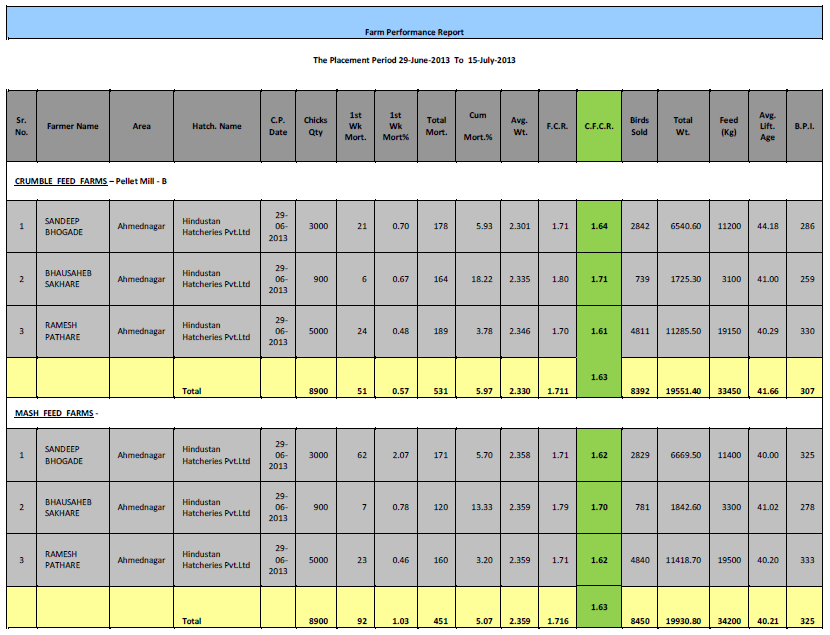Which Type of Feed is more Productive and Economical – Mash or Crumble/Pellet?
I was surprised when I saw the actual field reports under parallel trial taken on Mash Feed vs. Crumble Feed. It has been observed that everybody in the feed industry gives preference to Crumble/Pellet feed rather than Mash feed. The main reason is its better digestibility, palatability and finally better performance in terms of FCR over mash feed.
But nowadays, due to the use of high quality mixers in mash feed plants, the CV of the end product is excellent which leads to better performances on field levels. There are many pros and cons of both feed processes i.e. mash as well as Crumble/pellet. Regarding crumble/pellet feed, many people talk about the benefits of incremental energy generated during the pelletization process compared to mash feed but actual below field trial reports do not support this. According to experts, there are chances of harm to nutritional value of feed ingredients, feed additives and feed supplements in the process of pelletization if not properly handled.
Study shows that on the economical ground it’s not advisable to put the crumble/pellet mill and instead of that give preference to mash plant. For 12 Mts per hour production capacity pellet mill & mash plant, the project cost difference will be approximately around 3 Crores ( Land & machinery) and to recover this extra paid cost on pellet mill, that much benefits we are not getting from it.
To arrive at a solid conclusion, whether to put pellet mill or not, we have conducted the field trials to know the exact benefits gained.
Materials & Methods
We have selected same feed formulations with same ingredients and nutrient values for both mash and crumble feed.
To avoid the discrepancies, we have manufactured mash feed in our own feed mill and then send that feed for pelletization in 2 different renown pellet mills.
Sampling Method
Different R & D farms selected & parallel trial taken on both mash & crumble/pellet feeds.
Result
Discussions
No significant performance difference observed under trial Mash Vs Crumble/Pellet Feed.
Conclusion
As per outcome of study it’s not advisable to put a pellet mill by doing so much investment over mash plant.
Appeal
Request to readers to take such trials at your end & guide us to take a decision.
.jpg&w=3840&q=75)

Lifecycle data on the sustainability of rendered products
.jpg&w=3840&q=75)

Lifecycle data on the sustainability of rendered products
Great discussion
Congratulation Dr Jaydip Mulik for the trial.
I would also like to thank for the comments of others participants who like pelleting. Dave Albin gives us a short / great overview with are the advantages of pelleting. There is also to mention the extrusion which makes feed still more effective.
But there is an economical factor which is in some parts of the world (sorry everywhere)is important and often some added values, as pelleting, are not to cope.
Let me tell you one experience I have from other continent.
One friend of mine (South America, Peru) likes pelleted feed, because of the reasons Dave is mentioning, but in his region pelleted feed for his laying hens is too expensive. He was looking how to improve the profitability of his farm and one solution for him was to check more exactly the fiber level in his feed. Or to be more exactly the kind of fiber source his feed have (As you for sure know crude fiber is one way to expres the fiber level in the feed. But since there is from day to day more knowladge that there is a huge difference between insoluble and soluble fiber, we (nutritionists, farmers etc.) have to go more forward and know not just the crub fiber, but also de insoluble and soluble fiber level in the feed).
In some way he got the information that the insoluble fiber keeps the feed longer in gizzard, which helps the chicks to digest better the feed (some tells that the same effect has the pelleted feed).
He feed his hens with the same feed he used before but he started to add insoluble fiber concentrate ARBOCEL (week 8 till week 18 of age).
Let me try to put in short list the changes:
- feed consumption was more or less the same
- more weight uniformity
- the average LW of the chicks a bit higher (we have published results on this issue)
- 12 days earlier they started to lay (normaly in week 18)
- in week 18, 80 % of the hens where laying
- feaces was much dry (les amonia, less energy for ventilation, easier cleaning, etc.)
- les larvicid (to combat the fly larves in the feasea) is used since the feaces is dryer because is more concentrated
- about the egg size, we do not have any information but he wasn´t complaining (in Ecuador one other costumer do a similar trial and the eggs are 1 g bigger / heavier)
- no uterine prolapse (he thought it would be a case since they started to lay earlier)
We have much more trials and publications on functionality of our insoluble fiber concentrates.
Let me take the possibility to inform you that I will be at the IPPE en of this january at the booth A2529. You are welcome to visit as and we will give you more information about our product.
Dear All,
Thanks to all for active participation in the forum. I absolutely agree with the remarks & benefits of pelletization mentioned by everybody but practically on field those benefits are not supporting to theory.
We have conducted same trials 3 times before & again one trial going on. On that report I will update you soon.
We have done the pelletization of feed in different Pellet mills i.e. Indian made as well as in Imported pellet plants but results are same.
What I feel that nobody in India have done such experiments on field before putting the pellet plant.
Whenever the excess revenue generated through the farming & business everybody have invested in Pellet technology.
Still I am firm that if anybody willing to produce feed for own consumption then pellet mill is not economical & if interested to sell the commercial feed then he can think to put a pellet mill because its market trend & demand.
Dear Mr. Anaz,
1)Did you use the same feed formulation for both pellet ,and mash?...YES - We have first manufactured the mash & same was sent for pelletization to pellet mill. Done the same trial twice on different nutrient profile medium as well as dense nutrient profile
.
2)What was the calorie/ protein ratio? Find below
Ingredients Feed (In kg)
BROILER PRESTARTER BROILER STARTER BROILER GROWER BROILER FINISHER 1 BROILER FINISHER 2
Maize 666.560 696.855 719.150 731.995 745.320
Jowar - - - - -
B.Rice - - - - -
Wheat - - - - -
Bajra - - - - -
Ragi - - - - -
R.Polish - - - - -
DORB - - - - -
Sun flower meal - - - - -
Ground Nut DOC - - - - -
Soya DOC 212.000 169.000 144.000 112.000 91.000
Rapeseed Meal - - - - -
LSP 4.600 4.800 3.550 2.250 2.350
Grit - - - - -
DCP - - - - -
Fish meal - - - - -
Fish meal Salted - - - - -
MBM 69.000 70.000 70.000 70.000 70.000
Soya Crude Oil 1.500 11.000 15.000 15.500 16.000
Maize glutein - - - - 10.000
NSP Enzyme - - - - -
Full fat soybean - - - - -
Wheat bran - - - - -
Til cake - - - - -
Copra meal - - - - -
Molasses - - - - -
Cassava - - - - -
Rice Gluten - - - - -
whole fish - - - - -
Jawla Fish - - - - -
Blood Meal 28.000 30.000 30.000 40.000 36.000
Tallow - - - 10.000 11.000
Water - - - - -
VRK Enzyme - - - - -
VRK Phytase - - - - -
VRK DCP - - - - -
Sub Total 981.660 981.655 981.700 981.745 981.670
Sakar Premix
Ingredients Pre Starter Starter Grower Finisher 1 Finisher 2
Maize 55.60 55.30 63.35 65.20 59.25
A1154 - - - - -
A1167 - - - - -
Rovimix Ovn Ayn - - - - -
Brovit Plus - - - - -
Broiler Vitamin Premix 5.000 5.000 5.000 4.000 4.000
Kemtrace - - - - -
Avila ZMC - - - - -
Broiler Tm 400 Cir - - - - -
Tracemineral- Iffco 10.000 10.000 10.000 10.000 10.000
Roviclin - - - - -
Cygro - - - - -
Cycostat 4.000 4.000 4.000 4.000 4.000
CMP 200 - - - - -
Coxistac - - - - -
Monacox - - - - -
- - - - - -
Tylan (100) - - - - -
Colifeed Mix - - - - -
CTC 15% - - - - -
Arofac - - - - -
Biocholine 10.000 10.000 10.000 10.000 10.000
Nutrikem B - - - - -
Lipidin - - - - -
Natuzyme 2.000 2.000 2.000 3.000 4.000
Axtra Xap - - - - -
Bergapur - - - - -
Lysofort Dry - - - - -
Avitrim - - - - -
Staquinol Plus 1.500 1.500 1.500 1.500 1.500
Lactomax Gold Fs - - - - -
Endox C - - - - -
Proviguard - - - - -
Liv - 52 Protec Powder - - - - -
Zigbir - - - - -
- - - - - -
Mycocurb Aw Ds - - - - -
Acify Dry - - - - -
Formycine Gold Px - - - - -
Zanitizer - - - - -
DLM 33.600 31.700 27.250 27.350 25.750
L-Lysine 18.300 20.000 16.900 14.950 21.500
Phyzyme Xp 5000 G - - - - -
L-Threonine - 0.500 - - -
L- Trytophan - - - - -
UTPP Biotech - - - - -
Toxfin - - - - -
Toxy-nil Dry - - - - -
Fixar 10.000 10.000 10.000 10.000 10.000
Sub Total 150.000 150.000 150.000 150.000 150.000
Anichol 60 - - - - -
Choline Chloride 60% 1.000 1.000 1.000 1.000 1.000
- - - - - -
Sodium Bicarbonate - - - - -
Salt 2.340 2.345 2.300 2.255 2.330
Sub Total 3.340 3.345 3.300 3.255 3.330
Grand Total 1,000.000 1,000.000 1,000.000 1,000.000 1,000.000
.jpg&w=3840&q=75)

Lifecycle data on the sustainability of rendered products
Dear All,
I do agree with the benefits of pelletization such as 1) keeping quality 2) feed intake 3) mask unpatability 4) densification etc. However, the nutritional benefits are not many. The feed passes through the pellet mill around less that 10 minutes depending on the coditional augur. The temperature goes to around 70 deg C, the pressure of steam in pellet mill is 1 bar, the quantity of steam ised is 10% of mash pelletized. In such conditions, the mask nutrients will remain unchanged. The difference between indian and impoered pellet mill is the capacity produced. Bühler introduced a kettle process before pelletization for 30 minutes later discontinued. Considering the benefits pelletization is better.
Dry type fish feed extruder contributes to making pellets of different diameters (0.9-15mm) and shapes. Easier to use and operate.































